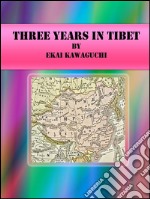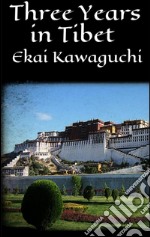Ekai Kawaguchi eBooks
eBooks editi da Ekai Kawaguchi di Formato Mobipocket
Three years in Tibet. E-book. Formato Mobipocket Ekai Kawaguchi - Ekai Kawaguchi, 2016 -
In the month of May, 1897, I was ready to embark on my journey, which promised nought but danger and uncertainty. I went about taking leave of my friends and relatives in Tokyo. Endless were the kind and heartfelt words poured on me, and many were the presents offered me to wish me farewell; but the latter I uniformly declined to accept, save in the form of sincerely given pledges. From those noted for excessive use of intoxicants, I exacted a promise of absolute abstinence from “the maddening water;” and from immoderate smokers I asked the immediate discontinuance of the habit that would end in nicotine poisoning. About forty persons willingly granted my appeal for this somewhat novel kind of farewell presents. Many of these are still remaining true to the word then given me, and others have apparently forgotten them since. At all events, I valued these “presents” most exceedingly. In Osaka, whither I went after leaving Tokyo, I also succeeded in securing a large number of them. Three of them I particularly prized, and should not fail to mention them here; for, as I think of them now, I cannot help fancying that they had transformed themselves into unseen powers that saved me from the otherwise certain death.
Three Years in Tibet . E-book. Formato Mobipocket Ekai Kawaguchi - Ekai Kawaguchi, 2016 -
I was lately reading the Holy Text of the Sa??harma-Pu?darika (the Aphorisms of the White Lotus of the Wonderful or True Law) in a Samsk?? manuscript under a Bo?hi-tree near M?ga-?ava (Sarana?h), Benares. Here our Blessed Lord Bu??ha Shakya-Muni taught His Holy ?harma just after the accomplishment of His Bu??hahood at Bu??hagaya. Whilst doing so, I was reminded of the time, eighteen years ago, when I had read the same text in Chinese at a great Monastery named Ohbakusang at Kyoto in Japan, a reading which determined me to undertake a visit to Tibet. It was in March, 1891, that I gave up the Rectorship of the Monastery of Gohyakurakan in Tokyo, and left for Kyoto, where I remained living as a hermit for about three years, totally absorbed in the study of a large collection of Bu??hist books in the Chinese language. My object in doing so was to fulfil a long-felt desire to translate the texts into Japanese in an easy style from the difficult and unintelligible Chinese. But I afterwards found that it was not a wise thing to rely upon the Chinese texts alone, without comparing them with Tibetan translations as well as with the original Samsk?? texts which are contained in Mahayana Bu??hism. The Bu??hist Samsk?? texts were to be found in Tibet and Nepal. Of course, many of them had been discovered by European Orientalists in Nepal and a few in other parts of India and Japan. But those texts had not yet been found which included the most important manuscripts of which Bu??hist scholars were in great want. Then again, the Tibetan texts were famous for being more accurate translations than the Chinese. Now I do not say that the Tibetan translations are superior to the Chinese. As literal translations, I think that they are superior; but, for their general meaning, the Chinese are far better than the Tibetan. Anyhow, it was my idea that I should study the Tibetan language and Tibetan Bu??hism, and should try to discover Samsk?? manuscripts in Tibet, if any were there available. With these objects in view, I made up my mind to go to Tibet, though the country was closed not only by the Local Government but also by the surrounding lofty mountains.

